




What Makes a Quadrilateral Cyclic? Core Properties and Shortcuts
To understand what a cyclic quadrilateral is, we should know what quadrilaterals are. A quadrilateral is called a closed, two-dimensional geometrical figure with four sides, four angles, and four vertices. Square, rectangle, rhombus, and trapezium are a few examples of quadrilaterals.
A four-sided shape that a circle can encircle is a cyclic quadrilateral. The quadrilateral ABCD in the given figure is cyclic because each of its four vertices—A, B, C, and D—lies on the circle's circumference. The cyclic quadrilateral, its definition, theorems, properties, angles, and examples of cyclic quadrilateral problems with solutions are all covered in detail in this article.
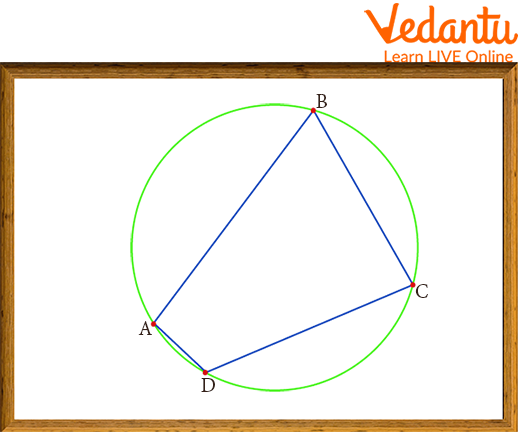
An Inscribed or Cyclic Quadrilateral
Properties of Cyclic Quadrilateral
Here some properties of cyclic quadrilateral angles are listed below:
The total of either pair of opposite angles in a cyclic quadrilateral is supplementary, i.e. 180 degrees.
For a quadrilateral to be cyclic, its opposing angles must be supplementary to one another.
In a cyclic quadrilateral, the sum of the products of its two pairs of opposite sides equals the product of the diagonals.
In a cyclic quadrilateral exterior angle is equal to the interior opposite angle if only one side is produced.
Angles of Cyclic Quadrilateral
Let's assume that $A B C D$ is quadrilateral, whose vertices are on a circle. Let's demonstrate a cyclic quadrilateral whose opposite angles are supplementary.
Join the circle's centre $O$ to each vertex. We see four radii $O A, O B, O C$ and $O D$, giving rise to four isosceles triangles $\triangle O A B, \triangle O B C, \triangle O C D$ and $\triangle O D A$. We already know that the sum of the angels surrounding the circle's centre is $360^{\circ}$ circles and that the sum of the angles in each triangle is $180^{\circ}$ circles.
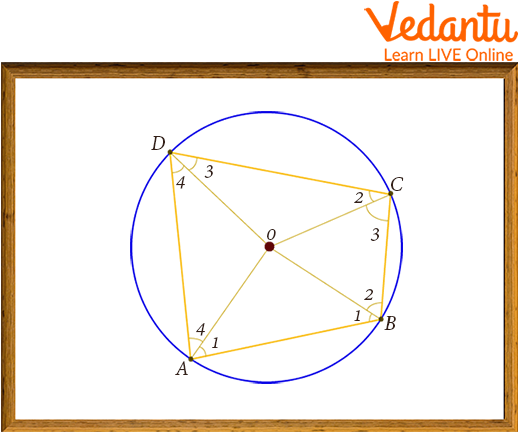
Cyclic Quadrilateral ABCD
Therefore, we get from the figure:
$2(\angle 1+\angle 2+\angle 3+\angle 4)+$ Angle at centre $\mathrm{O}=4 \times 180^{\circ}$
$2(\angle 1+\angle 2+\angle 3+\angle 4)+360^{\circ}=720^{\circ}$
$(\angle 1+\angle 2+\angle 3+\angle 4)=180^{\circ}$
We now interpret this as:
1. $(\angle 1+\angle 2)+(\angle 3+\angle 4)=180^{\circ}$ (Sum of opposite angles of a cyclic quadrilateral)
2. $(\angle 1+\angle 4)+(\angle 2+\angle 3)=180^{\circ}$ (Sum of opposite angles of a cyclic quadrilateral)
Cyclic Quadrilateral Theorems
There are three main theorems on the cyclic quadrilateral. These are discussed below.
Theorem 1: “In a cyclic quadrilateral, the sum of either pair of opposite angles is supplementary.”
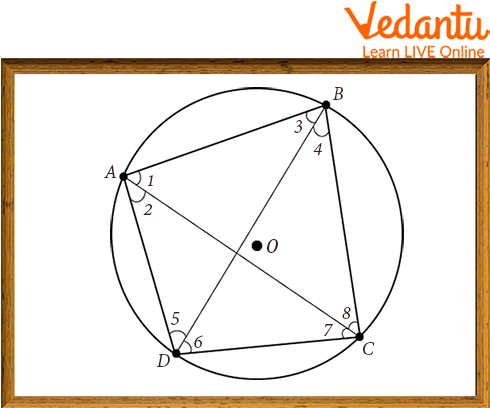
Cyclic Quadrilateral ABCD
Proof: Given: ABCD is a cyclic quadrilateral of a circle with a centre at $O$
To prove:
$\angle B A D+\angle B C D=180^{\circ}$
$\angle A B C+\angle A D C=180^{\circ}$
$A B$ is the chord of the circle
$\angle 5=\angle 8 \ldots$ (1) (Angles in the same segment are equal)
$\mathrm{BC}$ is the chord of the circle
$\angle 1=\angle 6 \ldots$ (2) (Angles in the same segment are equal)
$C D$ is the chord of the circle
$\angle 2=\angle 4 \ldots$ (3) (Angles in the same segment are equal)
$A D$ is the chord of the circle
$\angle 7=\angle 3 \ldots$ (4) (Angles in the same segment are equal)
By angle sum property of a quadrilateral
$\angle \mathrm{A}+\angle \mathrm{B}+\angle \mathrm{C}+\angle \mathrm{D}=360^{\circ}$
$\angle 1+\angle 2+\angle 3+\angle 4+\angle 7+\angle 8+\angle 5+\angle 6=360^{\circ}$
$(-1+\angle 2+\angle 7+\angle 8)+(-3+\angle 4+\angle 5+\angle 6)=360^{\circ}$
$(-1+\angle 2+\angle 7+\angle 8)+(\angle 7+\angle 2+\angle 8+\angle 1)=360^{\circ}$
From equation
$(1),(2),(3)$, and (4)
$2(\angle 1+\angle 2+\angle 7+\angle 8)=360^{\circ}$
$(\angle 1+\angle 2+\angle 7+\angle 8)=180^{\circ}$
$\angle B A D+\angle B C D=180^{\circ}$
Similarly,
$\angle A B C+\angle A D C=180^{\circ}$
Hence proved.
Theorem 2: Ptolemy’s Theorem: “If there is a quadrilateral inscribed in a circle, then the product of the diagonals is equal to the sum of the product of its two pairs of opposite sides.”
If ABCD is a cyclic quadrilateral,
AB and CD, and AD and BC are opposite sides.
AC and BD are the diagonals.
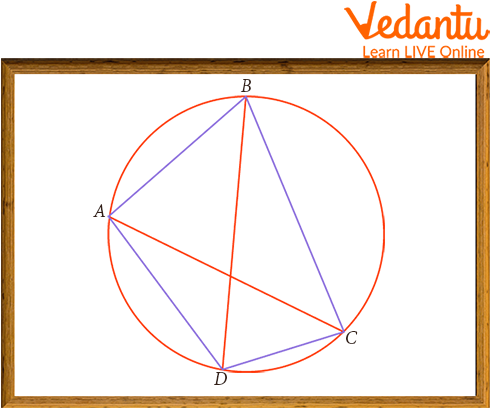
Cyclic Quadrilateral (Ptolemy's Theorem )
(AB×CD)+(AD×BC)=AC×BD
(AB×CD)+(AD×BC)=AC×BD
Theorem 3: “If one side of a cyclic quadrilateral is produced, then the exterior angle is equal to the interior opposite angle.”
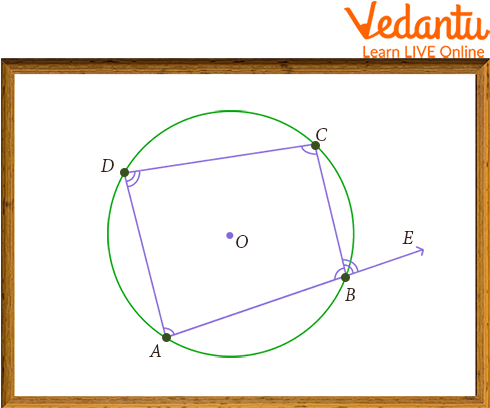
Cyclic Quadrilateral
To prove:
$\angle CBE=\angle ADC$
$\angle CBE=\angle ADC$
Proof:
Let the side $AB$ of the cyclic quadrilateral $ABCD$ be extended to $E$.
Here, $\angle ABC$ and $\angle CBE$ are linear pairs, their sum is $180 \circ$, and the angles $\angle ABC$ and $\angle ADC$ are the opposite angles of a cyclic quadrilateral, and their sum is also $180^{\circ}$
From this,
$\angle ABC+\angle CBE=\angle ABC+\angle ADC$
and finally, we get
$\angle CBE=\angle ADC$.
Similarly, we can prove it from all angles.
Solved Examples
Example 1: If ABCD is a cyclic quadrilateral, find the value of x and y.
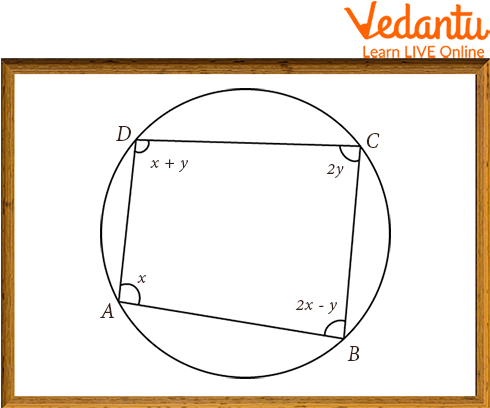
Cyclic Quadrilateral
Solution: We know that the sum of opposite angles of a cyclic quadrilateral is 180.
Therefore, from the figure
$\angle B A D+\angle B C D=180^{\circ}$
$x+2 y=180^{\circ} \ldots \text { (i) }$
Also,
$\angle A D C+\angle C B A=180^{\circ}$
$(x+y)+(2 x-y)=180^{\circ}$
$3 x=180^{\circ}$
$x=60^{\circ}$
Substitute $x=60^{\circ}$ in equation (i) we get;
$2 y=180^{\circ}-60^{\circ}$
$y=120 / 2=60^{\circ}$
Hence, the value of $x=y=60^{\circ}$.
Example 2: If PS || RQ and PQRS are cyclic quadrilaterals, determine the value of $\angle PQR$.
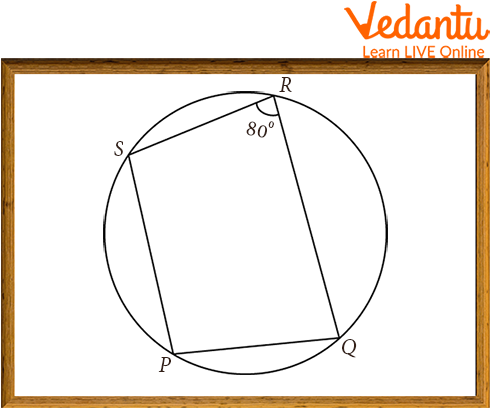
Cyclic Quadrilateral
Solution: PQRS is a cyclic quadrilateral, so the sum of either pair of opposite angles is 180 degrees.
$\angle P+\angle R=180^{\circ}$
$\angle P+80^{\circ}=100^{\circ}$
$\angle P=100^{\circ}$
Given PS || RQ. So, the Sum of interior angles is
$\angle \mathrm{SPQ}+\angle \mathrm{PQR}=180^{\circ}$
$\angle \mathrm{PQR}+100^{\circ}=180^{\circ}$
$\angle \mathrm{PQR}=80^{\circ}$
Hence, the value of $\angle P Q R$ is $80^{\circ}$.
Practice Questions
Q 1. PQRS is a cyclic quadrilateral. Diagonal PR and QS meet at A. If $\angle PAQ=110^{\circ}$ and$\angle RQS=30^{\circ}$ then $\angle PSQ$ measures
(a) $80^{\circ}$
(b) $70^{\circ}$
(c) $30^{\circ}$
(d) $50^{\circ}$
Ans: (a)
Q 2. In a cyclic quadrilateral ABCD, $\angle BCD= 120^{\circ}$ passes through the centre of the circle. Then the measure of $\angle ABD$ is
(a) $120^{\circ}$
(b) $30^{\circ}$
(c) $80^{\circ}$
(d) $50^{\circ}$
Ans: (b)
Summary
The four sides of a cyclic quadrilateral are the chords of the circle. An inscribed quadrilateral is another term for the cyclic quadrilateral. For a quadrilateral to be cyclic, its opposing angles must be supplementary to one another. The cyclic quadrilateral, its definition, theorems, properties, angles, and examples of cyclic quadrilateral problems with solutions are all covered in detail in this article. We hope this article will clear all our doubts regarding this topic.
FAQs on Cyclic Quadrilateral Explained: Key Concepts & Examples
1. What is a cyclic quadrilateral?
A cyclic quadrilateral is a four-sided polygon where all four of its vertices lie on the circumference of a single circle. This circle is known as the circumcircle, and the vertices are said to be concyclic. In simpler terms, it's a quadrilateral that can be perfectly inscribed within a circle.
2. What are the key properties of a cyclic quadrilateral?
The most important properties of a cyclic quadrilateral are:
Opposite Angles: The sum of a pair of opposite angles is always 180 degrees (supplementary). For a quadrilateral ABCD, this means ∠A + ∠C = 180° and ∠B + ∠D = 180°.
Perpendicular Bisectors: The perpendicular bisectors of all four sides are concurrent, meaning they meet at a single point, which is the centre of the circumcircle (the circumcenter).
Intersecting Diagonals: If the diagonals AC and BD intersect at a point P, then the product of the segments of the diagonals are equal (AP × PC = BP × PD). This is an application of the Intersecting Chords Theorem.
Exterior Angle: The exterior angle at any vertex is equal to the interior opposite angle. For example, the exterior angle at vertex D is equal to the interior angle ∠B.
3. What is the most important theorem related to the angles of a cyclic quadrilateral?
The fundamental theorem for cyclic quadrilaterals, as per the CBSE syllabus, states that the sum of either pair of opposite angles of a cyclic quadrilateral is 180°. The converse of this theorem is also true and equally important: if the sum of a pair of opposite angles of a quadrilateral is 180°, then the quadrilateral is cyclic.
4. How can you determine if a given quadrilateral is cyclic?
To check if a quadrilateral is cyclic, you must verify if a pair of its opposite angles adds up to 180°. For a quadrilateral with angles A, B, C, and D, you need to measure the angles and check if either ∠A + ∠C = 180° or ∠B + ∠D = 180°. If this condition is met, the quadrilateral is cyclic, and a circle can be drawn through all four of its vertices.
5. Are all special quadrilaterals, like rectangles and parallelograms, cyclic? Explain the conditions.
Not all special quadrilaterals are cyclic. The condition depends on their angle properties:
Rectangles and Squares: Yes, all rectangles and squares are cyclic. All their interior angles are 90°, so the sum of opposite angles is always 90° + 90° = 180°, satisfying the condition.
Parallelograms and Rhombuses: A general parallelogram or rhombus is not cyclic. In these shapes, opposite angles are equal, but not necessarily supplementary. A parallelogram is only cyclic if it is a rectangle, and a rhombus is only cyclic if it is a square.
Isosceles Trapeziums: Yes, an isosceles trapezium is always cyclic because its base angles are equal, which leads to its opposite angles being supplementary.
6. Why is the sum of opposite angles in a cyclic quadrilateral always 180 degrees?
This property is a direct consequence of the circle theorem which states: 'The angle subtended by an arc at the centre is double the angle subtended by it at any point on the remaining part of the circle.' Let's consider opposite vertices B and D of a cyclic quadrilateral ABCD. The angle at vertex B (∠B) is subtended by arc ADC. The angle at vertex D (∠D) is subtended by arc ABC. Together, these two arcs make a full circle (360° at the centre). Therefore, the sum of the angles they subtend on the circumference (∠B + ∠D) must be half of 360°, which is 180°.
7. What is the significance of the intersection point of the diagonals in a cyclic quadrilateral?
The diagonals of a cyclic quadrilateral are essentially chords of its circumcircle. When these diagonals intersect, they demonstrate a key property known as the Intersecting Chords Theorem. If the diagonals of quadrilateral ABCD, AC and BD, intersect at a point P, they divide each other into segments such that the products of their lengths are equal. This relationship is expressed as AP × PC = BP × PD. This property is very useful for solving geometry problems involving unknown lengths within a cyclic quadrilateral.
8. Who is credited with first describing the properties of a cyclic quadrilateral?
The study of cyclic quadrilaterals has ancient roots, but the Indian mathematician and astronomer Brahmagupta (7th century CE) provided one of the earliest and most significant contributions. He established key properties and derived a famous formula for the area of a cyclic quadrilateral given its side lengths, now known as Brahmagupta's formula. His work laid a crucial foundation for the study of these geometric figures.

















